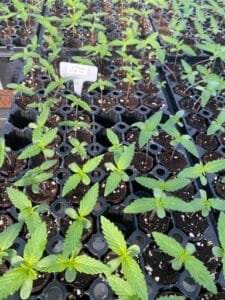When you’re new to autoflowering cannabis and hemp farming, it’s best to kick off your operation with all of the necessary information. Arming yourself with knowledge will help ensure that your season will go off without a hitch. Experienced farmers everywhere know that there are differences between direct sowing and transplanting crops. However, how does this difference affect your feminized autoflowering hemp seeds? Let’s take a look at the key differences between these two planting methods and explore potential benefits between direct sowing and transplanting your autoflowering cannabis. Atlas Seed is here to guide you and get your hemp farming season off on the right foot.
How Do I Best Plant Feminized Autoflowering Hemp and Cannabis Seeds?
Since feminized autoflowering cannabis and hemp are built for speed it is imperative to get out of the gate fast. Coming to the finish line between 60-70 days from first sowing your hemp seeds means there is no time to stumble. The gas pedal must be pegged at the floor from the first sign of your crop’s emergence. There are two options for hemp cultivators to deploy these fast finishing genetics.
Direct-Sowing Feminized Autoflower Cannabis and Hemp Seed:
As the autoflower seed emerges and begins to stake claim on the proximate soil particles it becomes very possessive of this space, not wanting to give up what it has come to own. Disturbing the roots of a feminized autoflower seed is the kiss of ultimate disappointment. An early flowering trigger, most generally induced by drought, light or wind stress on the root zone will lead to a stunted plant and conversely a lower yield.
There is a big difference in your bottom line when comparing a 1 to 4 oz bucked flower yield per cannabis plant. By Direct sowing your autoflower seeds into your field, you insure that your hemp plants never have to go through a potentially stressful transplanting event. It is important to remember that soil temperature plays a key role to your direct sowing success. You must wait until the soil temperature is at a sustained 70F. The warmer the soil the better the germination rate and the greater number of seeds will emerge out of the soil.
Soil, Moisture, and Emergence Considerations
It is important to be aware that direct sowing comes with two potential pitfalls. The first is whether adequate soil moisture levels are present at sowing to help crack the cannabis seed coat and send the cotyledon up to daylight without struggle. A second concern on the minds of hemp cultivators when direct sowing is whether a hard-to-break crust has formed on the surface of the field, usually after a strong rainfall has occurred just after sowing. Soils dominated by clay have a harder time supporting strong emergence rates.
Conversely sandy and sandy loam soils lend themselves to greater emergence rates and a greater number of usable autoflower cannabis plants. Currently the best risk mitigation for these concerns is to sow 3x as many seeds as you need usable plants per row. All of this is worth the trouble when you can reliably count on a direct sown seed to produce on average 15-20% more flowers than a transplanted seed.
Transplanting Feminized Autoflower Cannabis and Hemp Seed:
Ensure healthy rooted autoflowering hemp plants go into your field on transplanting day to achieve a full stand by harvest. Each bed foot is a valuable income producing piece of real estate. Holes or missing sections are not only difficult to look at but are also eating away at your bottom line. Transplanting autoflowering cannabis and hemp starts is the answer to a full and robust stand. However it does come with an added cost that direct sowing does not have to contend with. The labor, equipment and skill needed to precisely place the cannabis and hemp transplants safely in the soil takes time and costs money.
Here’s a short subheading for the second paragraph under Transplanting Feminized Autoflower Cannabis and Hemp Seed:
Steps for Successful Transplanting
It is important to sow your seed into a floating media transplant plug like an ellepot or a growcoon . The biodegradable wrapper allows the plug to stay intact while not disturbing the roots when being transplanted 8-10 days after sowing. (insert Atlas seed propagation guide) When propagating the seed in your germination chamber or greenhouse it is recommended to keep your soil temperatures above 75F. When it is time for transplanting it must be done during the cooler parts of the day, excluding the hottest midday temperatures. Close attention needs to be paid to the bed’s soil moisture 24-36 hrs prior to transplanting. Keep the bed damp to prevent the delicate transplant plug from losing moisture to dry soil. However, avoid making the bed muddy, as this will significantly slow down the transplanting process.
Turn on the irrigation system immediately after completing each row to raise the soil’s water-holding capacity to 100%. Pay close attention to these steps during the transplanting process to ensure your beds fill with ripe colas by harvest time.
We hope that this helps clear the air on some of the main differences between direct sowing and transplanting your feminized autoflowering cannabis and hemp seeds. Atlas Seed dedicates itself to providing quality information that helps you prepare adequately for each upcoming season. Check back in with us for more pertinent info for your hemp farming operation, and don’t forget to check out our autoflowering feminized seeds while you’re here!

